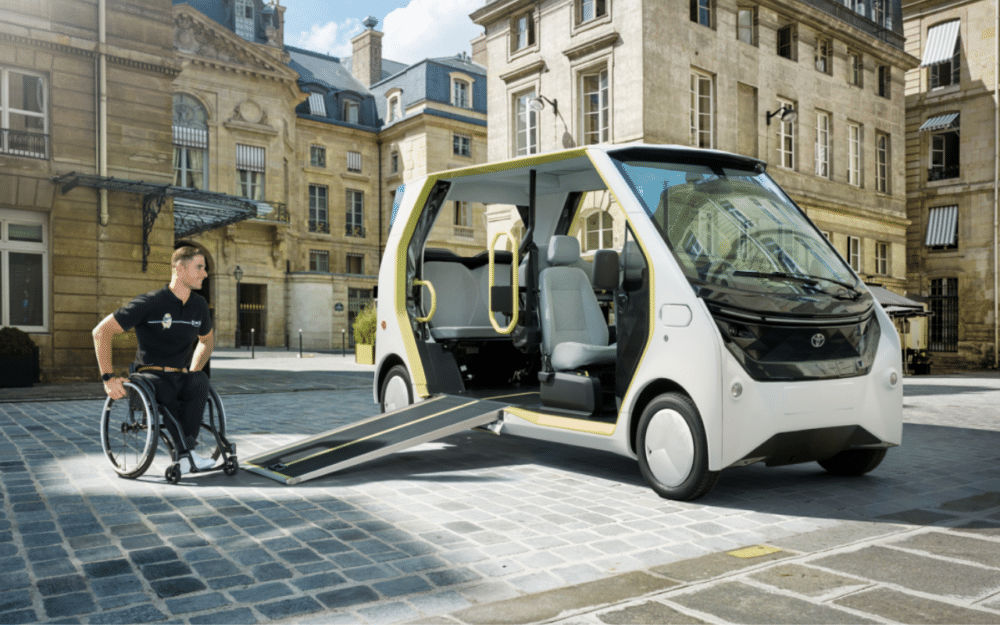Toyota, the official mobility partner for the Paris 2024 Olympic and Paralympic Games, has unveiled a series of cutting-edge mobility devices, either developed in-house or in collaboration with partners. These innovations, some specifically designed for the Games, others already available or nearing market release, showcase the company's commitment to inclusive mobility.
1. The Accessible People Mover (APM)
This electric vehicle, specifically designed for individuals with reduced mobility, features an accessibility ramp. Ideal for short-distance travel, it transported people within the Olympic Village during the Games. The APM's driver's seat can be removed to accommodate a wheelchair, enabling the person with reduced mobility to operate the vehicle. Capable of carrying six passengers, or four in wheelchairs, the APM boasts a compact design that maximises interior space whilst minimising its footprint. However, it is currently only intended for use during the Games and is not yet approved for public road use.
2. The Yosh-E
The Yosh-E is a traditional wheelchair transformed into an electric mobility device with a motorised third wheel. User-friendly, it operates with a simple pull-back mechanism for acceleration and push-forward for braking. The user remains fully autonomous at speeds up to 6 km/h. A mechanical brake, similar to a bicycle, activates when the user pushes forward to aid deceleration. For reverse travel, a multi-step process with buttons on the steering wheel ensures accidental reverse operation is prevented.
3. The C+Walk
The C+Walk is an electric scooter designed for pedestrian areas with a maximum speed of 6 km/h. It can be used standing or sitting, offering versatility for both able-bodied individuals and those with mobility needs. Users simply press buttons to move forward or reverse. The device also features an electric brake and automatically slows down when it detects an obstacle in front.
4. The Genny
A collaborative effort between Toyota and Swiss company Genny, the Genny combines Segway technology with a wheelchair. Essentially a seat on wheels with a steering mechanism, the user controls the forward or backward movement with their body. The challenge lies in finding the balance point, with the system moving backward when the user leans backward and vice versa. Genny can handle various terrains and reach speeds up to 15 km/h.
The Genny's genesis lies in Paolo Badano's experience. After a decade of wheelchair use, he suffered a severe shoulder injury due to prolonged wheelchair use. Observing a police officer on a Segway sparked the idea of combining Segway technology with a wheelchair. This led to the Genny Zero, a device designed to challenge stereotypes and barriers surrounding disability and mobility.
Unlike the Segway, which failed to gain widespread adoption, Paolo's Genny represents a new era of mobility. It is commercially available for â¬13,000.
5. Eppur and The First Braking System For Manual Wheelchairs
Eppur, a French startup and Toyota partner, has developed an innovative braking system for manual wheelchairs. Traditional wheelchairs lack a built-in braking system, forcing users to rely on pushing the handrail to stop, risking hand injuries from friction. Eppur's solution is Dreeft, a pair of wheels with a hub inspired by Dutch bicycle coaster brakes, easily attachable to manual wheelchairs.
Lancelot Durand, co-founder of Eppur, explains, "This system allows users to move forward, coast, brake and reverse without needing gloves or risking hand injuries." The design improves propulsion, eliminates slippery aluminum handrails, and aids independent navigation of inclines. "This is particularly beneficial for individuals with upper limb conditions, such as quadriplegics, those with multiple sclerosis, or amputees, who often struggle with traditional wheelchairs," Durand adds. Compatible with over 90% of wheelchairs, the system can also be combined with a small motor at the back for a versatile combination of manual and electric mobility.
6. WHILL: An AGV For People
Power chair manufacturer WHILL has developed the model C2, an innovative automatic-powered wheelchair controlled either by a predefined path or a tablet. This technology addresses a common challenge for individuals with mobility issues: efficiently and effortlessly loading their wheelchair into a vehicle. WHILL's system enables the wheelchair to automatically park itself at the rear of a vehicle equipped with a ramp, eliminating the need for manual intervention.
WHILL's autonomous capabilities truly shine. In large spaces, like airports, the wheelchair can be programmed to navigate users directly to their departure gate. For those seeking more independence, the wheelchair can be manually controlled. The system can detect obstacles and automatically stop to avoid collisions. The unique front wheels facilitate sharp turns, while the rear wheels handle primary steering, ensuring stability and precise maneuverability. Upon completion of its task, the wheelchair autonomously returns to its starting point.
Toyota's focus on inclusive mobility is fueled by Japan's aging population, necessitating innovative technological solutions. These smart mobility solutions will also be implemented in Woven City, Toyota's smart city project near Tokyo.
Article
Technology

Six Innovative Mobility Devices Revolutionising Accessibility

